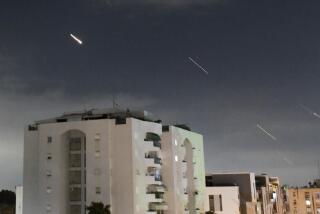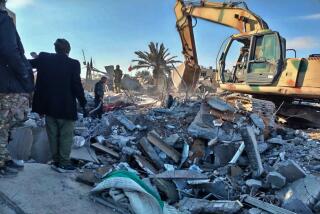Column: Trump wants to take on Iran but has no idea how to do that

Last week, U.S.-backed forces in Syria expelled Islamic State from its self-proclaimed capital of Raqqah, a major victory after three years of fighting against the “caliphate” that once terrified much of the West. But there was strikingly little celebration. President Trump made no formal announcement of success. There was no banner declaring “Mission Accomplished.”
That was partly because the struggle against Islamic State is no longer the main event. The Trump administration has already declared a broader war in the Middle East, this time against Iran.
“The [Iranian] regime remains the world’s leading state sponsor of terrorism,” Trump said Oct. 13. “The longer we ignore a threat, the more dangerous that threat becomes.” He said the United States will escalate its efforts — political, economic and military — to prevent Iran from expanding its influence across the Middle East.
Here’s the problem: The Trump administration doesn’t actually know how to accomplish that goal. Or if it does, it’s not telling anyone.
U.S. officials charge that most of the troops fighting for Assad in the Syrian civil war are Iranian-led proxy forces, not Syrian Army units.
Although the White House released a “New Strategy on Iran” this month, the four-page document was mostly a laundry list of grievances against Tehran, with no clear description of consequences for alleged misbehavior.
“There is no strategic plan,” complained James F. Jeffrey, a former senior official in the George W. Bush administration, who has advised Trump aides. “There’s no organizing principle.”
“He’s challenged Iran to a duel, but he hasn’t gotten any pistols out,” he said.
In Syria, Iran is projecting its power already. The Damascus government of Bashar Assad depends heavily on Iran for military and economic aid. And U.S. officials charge that most of the troops fighting for Assad in the Syrian civil war are Iranian-led proxy forces, not Syrian Army units.
Worse, Assad and his Iranian allies appear to be winning. The regime has gradually consolidated its control over most of western Syria, and now — amid the collapse of Islamic State — it’s moving into eastern Syria, too.
Last week, Iranian-backed government forces moved into Mayadeen, a town southeast of Raqqah that U.S.-backed rebels had hoped to seize. The area is important for two reasons: It’s a crossing point on the Iraqi border, and it’s near an oil and gas field that is a major prize in the war.
At this point the Trump administration faces a dilemma: Should it continue to supply training, weapons and air support to the Syrian rebels who took Raqqah, at the risk of clashes with government forces who not only have a friend in Iran, but also Russia?
It also needs to decide if it will keep hundreds of U.S. advisors inside Syria. The rebels, unsurprisingly, have said they hope the Americans will stay — “for decades to come,” one spokesman said recently.
Pulling them out would mean withdrawing help from a force the United States organized, trained and — last week — praised for its valor in battle. And it would deprive the United States of a tool to help prevent the Assad regime and its Iranian allies from taking over the territory that the rebels now hold.
“If you’re serious about pushing back against Iran, you have to stay involved,” said Frederic C. Hof, a former State Department official who now heads the Atlantic Council’s Rafik Hariri Center for the Middle East. “Otherwise, you’re just standing by as the Assad regime, the people who created the vacuum that allowed IS to grow, come back.”
But the advisors were deployed to help Syrian rebels in their fight against Islamic State, not in the civil war against the Assad regime.
Jeffrey, now at the Washington Institute for Near East Policy, suggested another alternative: a stronger U.S. alliance with Turkey, Saudi Arabia, Israel and other regional powers to bolster the Syrian rebels and keep Iran out.
“What we need to do is form an alliance to keep Iran from projecting its power further,” he said. “That’s not happening.”
As before, Syria offers only unappetizing choices. The United States can keep its troops in the country, at the risk of enmeshing them in Syria’s civil war. Or it can pull them out, which could mean acceding to increased Iranian influence — the problem Trump has promised to address.
The administration hasn’t chosen its course. That may be the worst alternative of all: drifting ahead without a clear plan.
That, after all, is what happened in Iraq after an earlier military success, the U.S. conquest of Baghdad in 2003. Military officials coined a bittersweet term to describe the results. It was, they said, a “catastrophic success.”
Twitter: @DoyleMcManus
Follow the Opinion section on Twitter @latimesopinion or Facebook
More to Read
A cure for the common opinion
Get thought-provoking perspectives with our weekly newsletter.
You may occasionally receive promotional content from the Los Angeles Times.







